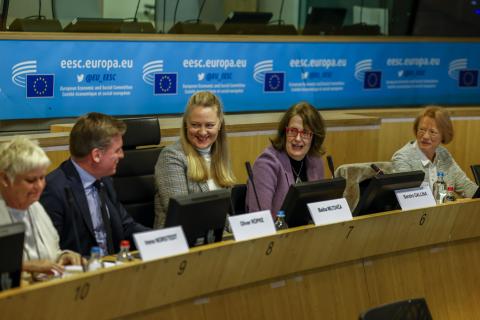European Economic
and Social Committee
Tackling #RareDiseases, next step: integrating European Reference Networks into national health systems
Following last year's rare diseases conference in Bilbao, the European Economic and Social Committee and the European Commission are joining forces to deal with rare diseases at European level.
Launching a joint European initiative on rare diseases to integrate the European Reference Networks (ERNs) into national health systems while building a common front among EU institutions, European countries, civil society organisations, patient associations, scientists, practitioners and hospital managers – these were the objectives of the conference on Rare Diseases in the EU: Joint Action shaping the future of ERNs held in Brussels on 8 March 2024.
The conference was organised by the European Economic and Social Committee (EESC) in cooperation with the European Commission's Directorate-General for Health and Food Safety (DG Sante).
EU health systems struggle to provide high-quality, cost-effective care when it comes to rare or low‑prevalence complex diseases which affect the daily lives of around 30 million Europeans.
That is why it is important to harness the potential of the European Reference Networks (ERNs), the virtual networks of healthcare providers across Europe which facilitate discussion on complex or rare diseases and conditions that require highly specialised treatment and concentrated knowledge and resources.
The Joint Action JARDIN
The Joint Action JARDIN is a project that is integrating the ERNs into national health systems and working to make them sustainable. It develops national patient pathways linked to ERNs, national reference networks mirroring and complementing the ERNs, and structures for undiagnosed patients.
The project involves the 27 EU Member States, Norway and Ukraine. It is coordinated by Austria and has total funding of EUR 18.75 million (EUR 15 million from the EU and EUR 3.75 million from the Member States) for a period of three years.
The results expected from JARDIN, including recommendations, blueprints and reports from concrete pilot projects, should lead to better national plans for rare diseases in EU Member States. JARDIN will therefore play a key policy role in the future development of ERNs and in the diagnosis, treatment and care of rare diseases.
To achieve this goal, the commitment of civil society organisations, in particular rare disease patient associations from across the EU, is key. Their involvement has been instrumental in the progress made so far, and their voice must continue to be heard in the next steps to be taken at EU level as part of the dialogue which has been become a reality thanks to the EESC's proposals.
As far back as October 2023, at the Bilbao conference on Rare diseases and the European Reference Networks, the Committee succeeded in involving the main patient organisations from across the EU and called for a European action plan stepping up European cooperation between health systems to fight rare diseases and provide better diagnosis, treatment and care.
Speakers' quotes
The conference, which was organised on the EESC side by the Section for Transport, Energy, Infrastructure and the Information Society (TEN) and the Section for Employment, Social Affairs and Citizenship (SOC), saw the participation of prominent speakers.
Our key objective is to establish a comprehensive European action plan for rare diseases, setting out actions to be completed by 2030. We need to ensure that all rare disease patients in the EU have equal opportunities for diagnosis, treatment and holistic integrated care. The EESC will continue to raise awareness of the Joint Action and rare diseases in general among a wider community of stakeholders. We will ensure continuity in the work and political commitments of the Member States and the EU institutions in the years to come.
Oliver Röpke, EESC President
In the European Health Union, nobody should be left behind, especially our fellow EU citizens fighting rare diseases. That means that we need robust EU cooperation so that everyone has access to timely diagnosis, affordable treatment and care – no matter where they live and no matter their disease. Putting patients at the centre, the EU has become a pioneer in this area. Today’s launch of a new Joint Action to integrate the European Reference Networks into national health systems is another testament of our unwavering commitment to improve the lives of those living with rare diseases.
Stella Kyriakides, European Commissioner for Health and Food Safety
I am proud that Austria had a key role in bringing this Joint Action to life. The Joint Action will support the implementation and adaptation of structures and guidelines, pathways of care, national reference networks and programmes for patients with undiagnosed rare diseases. As in many other EU-level health activities, we hope that it will increase equity in the field of rare diseases.
Johannes Rauch, Austrian Minister of Health
After calling for an EU strategy on rare diseases in October 2023, we now urge the EU to move forward and make Member States aware of the importance of developing more robust national plans for rare diseases. Nobody must feel alone in the nascent EU Health Union and today's kick-off meeting of the Joint Action JARDIN is a step in the right direction.
Baiba Miltoviča, President of the EESC’s Section for Transport, Energy, Infrastructure and the Information Society
As representative of organised civil society, the EESC will continue to give patient organisations a voice and facilitate dialogue between them and European Institutions. We would like to see the new European Commission adopt a comprehensive EU Action Plan on Rare Diseases and a Special EU Financial Fund to secure access to treatment for all Europeans with rare diseases.
Cinzia Del Rio, President of the EESC’s Section for Employment, Social Affairs and Citizenship (SOC)
Work organisation
Downloads
-
Tackling #RareDiseases, next step: integrating European Reference Networks into national health systems
